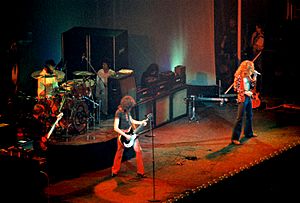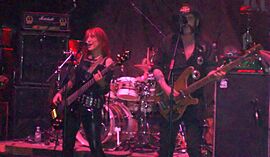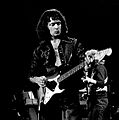Heavy metal music facts for kids
Quick facts for kids Heavy metal |
|
|---|---|

From left to Led Zeppelin performing at Chicago Stadium in January 1975
|
|
| Stylistic origins | Blues rock, Psychedelic rock, Hard rock |
| Cultural origins | Late 1960s/Early 1970s United Kingdom and United States |
| Typical instruments | Electric guitar, bass, drums, vocals |
| Subgenres | |
| Black metal - death metal - doom metal - folk metal - glam metal - gothic metal - power metal, progressive metal - speed metal - symphonic metal - thrash metal - viking metal (complete list) |
|
| Fusion genres | |
| Deathcore - grindcore - metalcore - nu metal | |
| Other topics | |
| Rock music | |
Heavy metal (or simply metal) is a type of rock music. It started in the late 1960s and early 1970s, mostly in the United Kingdom and United States. It has a strong, powerful sound. This sound comes from guitars that use a special effect called distortion. It also features long guitar solos, strong beats, and loud music.
In 1968, three very important bands helped create this music style. They were British bands Led Zeppelin, Black Sabbath, and Deep Purple. During the 1970s, some American bands made heavy metal sound a bit more friendly. These included Alice Cooper and Kiss with their wild stage shows. Aerosmith played blues-based rock, and Van Halen was known for fancy guitar playing and party songs.
In the 1980s, a style called glam metal became very popular. Bands like Bon Jovi, Mötley Crüe, and Poison were big names. At the same time, other types of metal grew in underground music scenes. Thrash metal became well-known with bands like Metallica, Slayer, Megadeth, and Anthrax. Other very intense styles, like death metal and black metal, became popular among smaller groups of fans. Since the mid-1990s, new styles have added to what heavy metal means. These include groove metal and nu metal. Nu metal often mixes in parts of grunge and hip-hop.
Contents
What Makes Heavy Metal Music Special?
Heavy metal music usually has loud, distorted guitars and strong rhythms. It also features a deep sound from the bass and drums, and powerful singing. Different types of heavy metal might change or leave out some of these features.
A typical heavy metal band has a drummer, a bass player, a rhythm guitarist, a lead guitarist, and a singer. Sometimes, the singer also plays an instrument. Keyboard instruments are sometimes used to make the sound fuller. For example, Deep Purple's Jon Lord played a special Hammond organ. By the 1990s, synthesizers were used in almost every type of heavy metal.

The Electric Guitar's Role
The electric guitar and its loud sound through amplifiers are key to heavy metal. The heavy metal guitar sound comes from playing at high volumes with a lot of fuzz (a type of distortion). For classic heavy metal, guitarists keep the sound clear but loud. This creates a powerful "punch and grind" sound. Thrash metal guitars often have a very tight and strong sound with lots of bass.
Guitar solos are a very important part of heavy metal. They show off how skilled the guitarist is. Most heavy metal songs have at least one guitar solo. However, some nu metal and grindcore bands do not use guitar solos. For rhythm guitar parts, a "heavy crunch sound" is made by using a technique called palm muting. This is when the guitarist lightly touches the strings with their picking hand while playing. Palm muting makes the sound tighter and emphasizes the low notes.
Singing in Metal
The guitar is often the main focus in heavy metal. This can create a friendly competition with the singer, as both try to stand out. Heavy metal music usually makes the voice fit in with the overall sound of the band. Singers need to show a lot of emotion to make the music feel real. Some critics say that the singer's "tone of voice" is more important than the actual words.
The Bass Guitar's Importance
The bass guitar is also very important to the metal sound. The way the bass and guitar work together is a key part of the music. The bass provides the deep, low sound that makes the music feel "heavy." The bass has a more important role in heavy metal than in most other rock music styles.
Metal basslines can be simple or very complex. They might hold a steady low note or play complicated riffs along with the guitars. Some bands even feature the bass as a lead instrument. Metallica's Cliff Burton was famous for his bass solos and for playing chords on the bass in the early 1980s. Lemmy from Motörhead often played loud, distorted power chords on his bass.
Drumming in Metal
Heavy metal drumming is about creating a loud, steady beat with "speed, power, and precision." Metal drummers need a lot of energy and skill to play the complex patterns used in this music. A common metal drumming technique is the cymbal choke. This is when a drummer hits a cymbal and then quickly grabs it to stop the sound, making a short burst of noise.
Metal drum kits are usually much bigger than those used in other rock music. Many black metal, death metal, and some mainstream metal bands use double-kicks (two bass drums) and blast beats (very fast drum patterns).
Loudness in Live Shows
When heavy metal bands play live, being loud is very important. It's meant to be a powerful "onslaught of sound." Early heavy metal bands like Blue Cheer made music louder than ever before. As Blue Cheer's Dick Peterson said, "All we knew was we wanted more power." Loudness helps pull the listener into the music and gives a feeling of youthful energy.
For a long time, most heavy metal performers were male. But by the 2010s, more women were making a big impact in metal. In power metal and symphonic metal, many bands have women as lead singers, such as Nightwish, Delain, and Within Temptation.
How Heavy Metal Music is Made
Rhythm and Speed
The rhythm in metal songs is very strong and clear. Drummers use many different sounds to make the rhythm complex yet powerful. In many heavy metal songs, the main rhythm uses short, quick musical ideas, often made of eighth or 16th notes. These are usually played with a sharp, clear sound by the rhythm guitar using palm-muting.
These short, sharp musical ideas are put together to create rhythmic patterns and melodies called riffs. Riffs help create memorable parts of the song. Heavy metal songs also use longer notes in slower songs, like power ballads. Early heavy metal music was often slow. But by the late 1970s, metal bands used many different speeds. Today, metal speeds can range from very slow to extremely fast.
Power Chords and Harmony
One of the most recognizable sounds in heavy metal is the guitar power chord. A power chord is quite simple. It usually involves just two notes played together: the main note (root) and another note a "perfect fifth" away. Sometimes, an octave (the same note but higher) is added.
When power chords are played on the lower strings at high volumes with distortion, they create extra deep sounds. This adds to the "weight of the sound" and makes it feel very powerful. While the perfect fifth is most common, power chords can also be based on other musical intervals. Most power chords are played with a finger shape that can be easily moved up and down the guitar neck.
Typical Music Structures
Heavy metal often uses riffs built with three main musical ideas:
- Modal scales: These are special types of musical scales, like the Aeolian and Phrygian modes.
- Tritone and chromatic progressions: These create a tense sound. A tritone is an interval (distance between two notes) that was once called "the devil in music" because it sounded so harsh.
- Pedal points: This is a sustained (held) note, usually in the bass, while other notes change around it.
Heavy metal music often uses complex musical structures. Experts have found that heavy metal's chord structures are much more complicated than many people first thought.
Images for kids
-
Ritchie Blackmore, founder of Deep Purple and Rainbow, known for his classical-inspired guitar playing.
-
Kiss performing in 2004, wearing their famous makeup.
-
A heavy metal fan wearing a denim jacket with patches from bands like Metallica, Guns N' Roses, Iron Maiden, Slipknot, Dio, and Led Zeppelin.
-
Led Zeppelin performing at Chicago Stadium in January 1975.
-
Brian Robertson, Phil Lynott, Scott Gorham of Thin Lizzy performing during the Bad Reputation Tour, 24 November 1977.
-
Iron Maiden, a key band in the new wave of British heavy metal.
-
Layne Staley of Alice in Chains, a popular band known for alternative metal, performing in 1992.
See also
 In Spanish: Heavy metal para niños
In Spanish: Heavy metal para niños




















